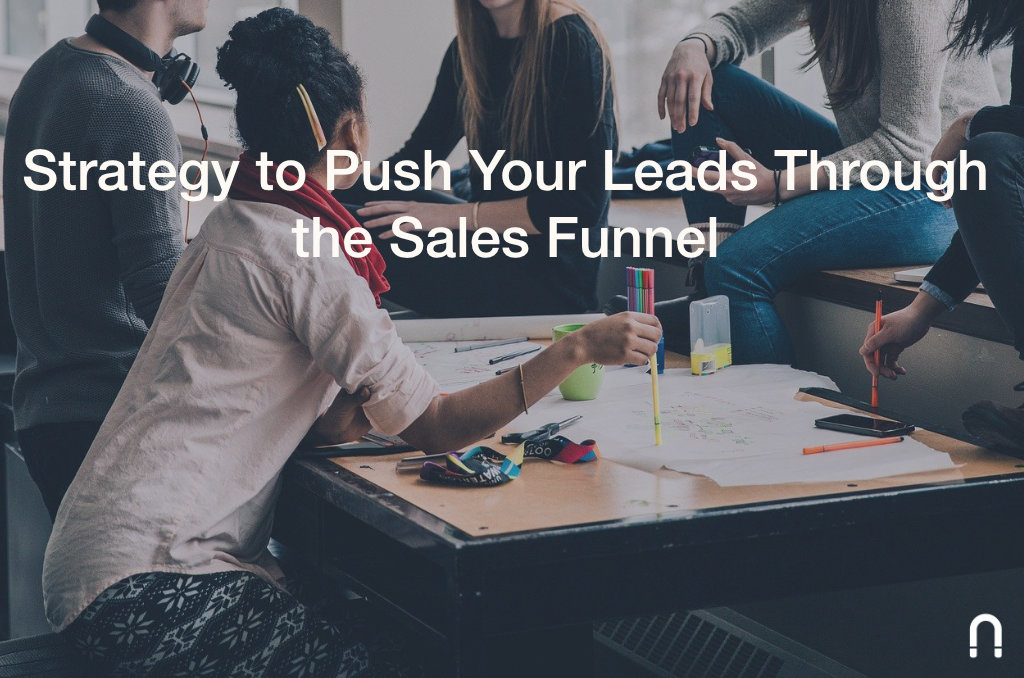Why you need to create a strategy to push your leads through the sales funnel
 Oct 25, 2018 - Marcel Odena
Oct 25, 2018 - Marcel OdenaIn this article I would like to talk about the need to create a strategy to push leads in the sales funnel . If you are developing a lead generation strategy based on content marketing, it is very likely that you will get many leads from people interested in the content that you offer them and yet they are little interested, at least a priori, in the product or service that you would like them to buy.
Is it possible that this is happening to you?
Diagnosis of the problem
Your company has to grow at a fast pace. As the marketing director of that company, you are responsible for generating qualified leads, people potentially buyers of the products offered by your company.
Following the philosophy championed by HubSpot on Inbound Marketing, you start to develop a strategy based on content marketing. You work with web positioning and with great success your marketing department gets to rank in first positions for a lot of keywords. Users access your website and start downloading the contents that you have created from marketing. Why? because these contents address the solution of concrete problems, are useful guides, interesting ebooks.
Do those contents of the product that your company sells speak?
Most likely not, at most there will be a page at the end or at some strategic point of the ebook presenting the solutions of your company.
Let’s imagine a possible sequence of events:
- The user downloads the ebook, reads it (or looks through it) and there it ends.
- After 2 days, a seller calls you to try to sell you the product or service offered by your company.
Success ratio? very low. The user simply had a question about how to do something and your company solved it with an ebook, with a blog article, etc. From there to the user being interested in buying the product or service of your company there is a long way.
The case is very similar to the lead generation tactic using content through Pay per Click Advertising (PPC). Suppose that through different types of campaigns on Linkedin we managed to generate dozens of leads. . These people have decided to download a specific ebook to learn something determined that the ebook promises, and certainly don’t intend to hire short-term services or products offered by your company . In many cases I would say that the user downloads the content without knowing the company or the services it offers. If we also use Lead Gen Form campaigns, it is likely that the user has not even accessed the website of your company, since the download of the ebook is done within the LinkedIn application itself, without abandoning it at any time.
Sales complains that it’s harder to sell to Inbound Leads.
This is a symptom of the problem described above and has its logic. If a user has downloaded an ebook through a campaign on LinkedIn without hardly having seen your company’s website it is normal that when he receives a call within a few days from a seller, his predisposition is low and his interest in what is offered lower.
To all this, surely the exception is the leads captured with demand-oriented campaigns such as Google Adwords or Bing Ads’ search campaigns (keywords) and the own organic positioning (SEO). And it has its logic: if a user has a problem that our product solves and goes to Google to do a search in which denotes that he looks for a solution, if we appear and capture the lead, most likely his predisposition to buy will be much higher.
When the goal is to generate pipe
And this is when the maxim of any company comes into play: generate pipe, as it is informally said, to generate business for the company, get customers with which to increase the monthly invoicing of the company (Monthly Recurring Revenue). And this is when the CEO of your company returns to your office and says: Hey look, you are doing a great job acquiring leads, we had never gotten so many leads before, but now you also have to contribute to generate “pipe”..
What does this mean? Well, not only do you have to worry about generating leads, but also to draw up a plan to achieve, in the shortest possible time, to make these leads progress through the sales funnel until a percentage of those leads ends up in sales.
Lowering the leads through the phases of the sales funnel.
Mentalize, nobody buys what they do not understand and here Marketing has a crucial task that is:
- Position your company in the “shortlist” of the user’s mind. . This is very important and more in B2B environments where the sales process can take several months. It is convenient for the user at all times to have your company in mind in the ranking of options to consider when buying.
- Educate the user: for this Marketing has the challenge of publicizing, disseminating and educating the user about the benefits of your product, what features it has, how it differs from the competition, which customers already use it, etc.
The phases by which we have to get the leads to pass are these:
1. Awareness Phase
The awareness phase is the first one through which a user passes, at some point through some of the actions we have made from marketing (or other areas of the company) a user is aware of the existence of the company. The user may be reading an article published in a digital newspaper that talks about our company and through a link access to our website. The user may have seen an ad that has raised his curiosity, click and access our page, the user may have performed a search on Google, Bing, etc. and have reached an article in our blog, etc. The roads can be very diverse, but what characterizes this phase is that the user goes from not knowing about your company to having knowledge that exists. From there to the user to inquire more there is a long distance. There will be a percentage of users who do continue to look at the web and there will be a percentage that will leave the page without more after a while or at the moment (bouncers). As for the leads generation, if we have managed to generate a lead with a content “Top Of The Funnel – TOFU” surely we have already achieved a first step towards making us know, that the user knows we exist. It’s enough? Not necessarily. We have to aspire to more and get the user to know that we exist, but also know what we are good at, on what we are positioned in the market, what solution we bring to the world. Therefore, all this must be communicated with several campaigns.
2. Interest Phase
It is necessary to generate interest to the user for our product or service . If we have done the previous duties we should know who our buyer persona is, what problems he usually faces in his work and how our solution can make his life easier. You have to address the user’s “pain points” to generate that “reasonable doubt”, that:” let me take a look at this, it looks good “. And we can achieve this with a good strategy and with many campaigns!
3. Consideration Phase
If we continue doing the job well we will get the user to go from showing interest in our product to reach that moment in which he considers, even for a moment, to say: “ Hey, my company could use this solution very well“. Perhaps in this stage the user comes to the conclusion that he needs to adopt a solution in his company to improve the management of certain aspects, but it is still not clear that we are the best option. We are making progress. Keep market-ing!
4. Purchase Phase
In this phase the user is clear that he needs to buy a solution like ours but he is surely evaluating several options before making the decision . It is possible that when the user is in this phase is also in contact with one of the sellers of your company, so the smartest thing is to coordinate sales and marketing to have a common approach. But it is also possible that at this point the user has not yet had contact with any sales agent, so everything that is done from marketing to convince the user is welcome. In this phase marketing should be focused on highlighting the virtues of our solution, to highlight competitive advantages as a company with respect to competition (without the need to appoint competitors), etc.
Objectives and KPIs of each phase of the funnel
Each phase of the funnel should have clear objectives and defined KPIs . These will allow us to measure the key metrics and assess the degree of compliance with the objectives based on the campaigns that we have active. From here we can improve and iterate the process. Do not forget that we are always talking about a funnel, this implies that only a percentage of the users that start in one phase complete it to enter the next phase.
We need to make progress as many more users as possible until the finish line, the purchase phase or at least advance them as much as possible. The closer to the purchase phase the closer we will be to generate business, to close the sale. Therefore it is super-important to have clear objectives of each phase, define key KPIs for each phase, create many campaigns to spin the wheel, measure, analyze, apply improvements to the campaigns, re-measure, and so on.
Comments, observations?
Have you encountered these problems? How do you think it is a good way to make users progress through the funnel? Which channels do you use preferably for each phase?
Let’s discuss!
Related articles
- How to optimize B2B Pay Per Click campaigns
- Is the Pay Per Click (PPC) world sexy?
- Basic concepts about B2B lead generation
- Account Based Marketing techniques to generate leads for qualified companies
- The phases of the B2B sales process
- Best practices for Inbound Marketing
- 5 examples of LinkedIn Campaigns for generating quality sales leads



